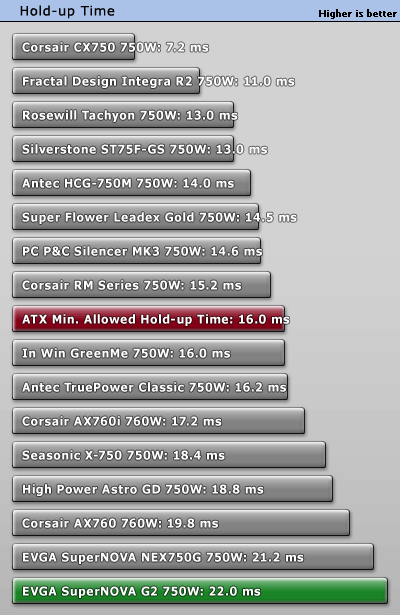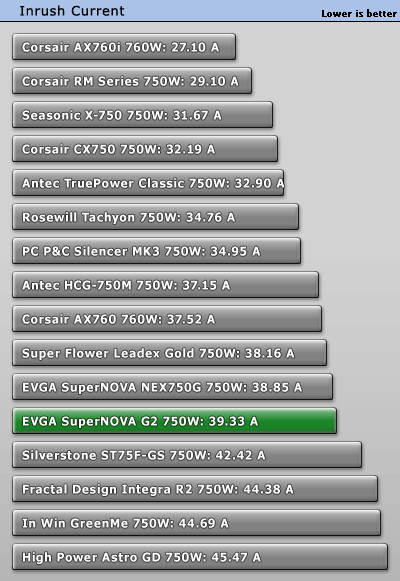 4
4
EVGA SuperNOVA G2 750 W Review
Efficiency, Temperatures & Noise »Test Setup
All measurements were performed using two Chroma 6314A mainframes equipped with the following electronic loads: six 63123A [350 W each], one 63102A [100 W x2], and one 63101A [200 W]. The aforementioned equipment is able to deliver 2500 W of load, and all loads are controlled by a custom-made software. We also used a Rigol DS2072A oscilloscope kindly sponsored by Batronix, a Picoscope 3424 oscilloscope, a Picotech TC-08 thermocouple data logger, two Fluke multimeters (models 289 and 175), and a Yokogawa WT210 power meter. We also included a wooden box, which, along with some heating elements, was used as a hot box. Finally, we had at our disposal three more oscilloscopes (Rigol VS5042, Stingray DS1M12, and a second Picoscope 3424), and a CEM DT-8852 sound level meter. You will find more details about our equipment and the review methodology we follow in this article. We also conduct all of our tests at 40°C-45°C ambient to simulate the environment seen inside a typical system with a higher accuracy, with 40°C-45°C being derived from a standard ambient assumption of 23°C and 17°C-22°C being added for the typical temperature rise within a system.Primary Rails Voltage Regulation
The following charts show the voltage values of the main rails, recorded over a range from 60 W to the maximum specified load, and the deviation (in percent) for the same load range.





5VSB Regulation
The following chart shows how the 5VSB rail deals with the load we throw at it.

Hold-up Time
Hold-up time is a very important PSU characteristic and represents the amount of time, usually measured in milliseconds, a PSU can maintain output regulations as defined by the ATX spec without input power. In other words, it is the amount of time the system can continue to run without shutting down or rebooting during a power interruption. The ATX specification sets the minimum hold-up time to 16 ms with the maximum continuous output load. In the following screenshot, the blue line is the mains signal and the yellow line is the "Power Good" signal. The latter is de-asserted to a low state when any of the +12V, 5V, or 3.3V output voltages fall below the undervoltage threshold, or after the mains power has been removed for a sufficiently long time to guarantee that the PSU cannot operate anymore.

Although the G2-750 uses the exact same platform and components as the Leadex Gold 750 unit, performance in this test was very different to the Leadex unit. The Leadex Gold 750 did not reach the minimum allowed time, but the GS-750 easily passed 16 ms and even reached 22 ms! We actually made a point of desoldering both bulk caps inside the G2-750 to shed some light on this mystery, and capacity measurements confirmed that their combined capacity is in line with the official specification. We could not do the same to the Leadex unit since it wasn't at our disposal anymore and can only speculate that its bulk caps were not in their best state, although something else might have severally affected the unit's hold-up time. This is the first time we have come across such a phenomenon, but are pretty sure that it is due to the Leadex's bulk caps.
Inrush Current
Inrush current or switch-on surge refers to the maximum, instantaneous input-current drawn by an electrical device when it is first turned on. Because of the charging current of the APFC capacitor(s), PSUs produce large inrush-current right as they are turned on. Large inrush current can cause the tripping of circuit breakers and fuses and may also damage switches, relays, and bridge rectifiers; as a result, the lower the inrush current of a PSU right as it is turned on, the better.
About one ampere more than the identical Leadex unit, but still under 40 A, so everything is fine here.
Voltage Regulation and Efficiency Measurements
The first set of tests revealed the stability of the voltage rails and the efficiency of the G2-750. The applied load was equal to (approximately) 20%, 40%, 50%, 60%, 80%, 100%, and 110% of the maximum load the PSU can handle.We conducted two additional tests. In the first test, we stressed the two minor rails (5V and 3.3V) with a high load while the load at +12V was only 0.10 A. This test reveals whether the PSU is Haswell ready or not. In the second test, we dialed the maximum load the +12V rail can handle while the load on the minor rails was minimal.
| Voltage Regulation & Efficiency Testing Data - EVGA G2-750 | ||||||||||
|---|---|---|---|---|---|---|---|---|---|---|
| Test | 12 V | 5 V | 3.3 V | 5VSB | Power (DC/AC) | Efficiency | Fan Speed | Fan Noise | Temp (In/Out) | PF/AC Volts |
| 20% Load | 10.549A | 1.982A | 1.994A | 0.990A | 149.77W | 90.55% | 0 RPM | 0 dBA | 49.03°C | 0.911 |
| 12.152V | 5.039V | 3.305V | 5.048V | 165.40W | 36.87°C | 230.1V | ||||
| 40% Load | 21.480A | 3.970A | 4.000A | 1.190A | 299.70W | 92.23% | 0 RPM | 0 dBA | 50.97°C | 0.966 |
| 12.130V | 5.030V | 3.298V | 5.027V | 324.95W | 37.68°C | 230.1V | ||||
| 50% Load | 26.832A | 4.969A | 5.006A | 1.596A | 374.71W | 92.14% | 810 RPM | 34.2 dBA | 41.31°C | 0.973 |
| 12.122V | 5.027V | 3.294V | 5.002V | 406.69W | 46.58°C | 230.1V | ||||
| 60% Load | 32.178A | 5.970A | 6.013A | 2.005A | 449.63W | 91.91% | 810 RPM | 34.2 dBA | 42.63°C | 0.977 |
| 12.116V | 5.023V | 3.291V | 4.978V | 489.23W | 48.25°C | 230.1V | ||||
| 80% Load | 43.094A | 7.969A | 8.034A | 2.422A | 599.57W | 91.05% | 1210 RPM | 46.7 dBA | 43.82°C | 0.983 |
| 12.095V | 5.016V | 3.285V | 4.948V | 658.50W | 50.29°C | 230.0V | ||||
| 100% Load | 54.643A | 8.983A | 9.053A | 3.058A | 749.50W | 90.00% | 1680 RPM | 47.8 dBA | 46.00°C | 0.987 |
| 12.075V | 5.009V | 3.280V | 4.903V | 832.75W | 53.80°C | 229.9V | ||||
| 110% Load | 60.910A | 8.987A | 9.059A | 3.061A | 824.38W | 89.45% | 1680 RPM | 47.8 dBA | 46.32°C | 0.988 |
| 12.062V | 5.007V | 3.278V | 4.897V | 921.65W | 54.35°C | 229.9V | ||||
| Crossload 1 | 0.097A | 14.015A | 14.005A | 0.003A | 117.64W | 83.25% | 1210 RPM | 44.5 dBA | 43.65°C | 0.894 |
| 12.166V | 5.019V | 3.292V | 5.068V | 141.31W | 49.78°C | 230.2V | ||||
| Crossload 2 | 62.455A | 1.001A | 1.003A | 1.002A | 766.81W | 90.50% | 1680 RPM | 47.8 dBA | 45.35°C | 0.987 |
| 12.064V | 5.021V | 3.291V | 5.011V | 847.30W | 52.45°C | 229.9V | ||||
The G2-750 scored pretty good efficiency for a Gold-certified unit, registering a peak of a little over 92% with typical loads.
Mar 6th, 2025 17:31 EST
change timezone
Latest GPU Drivers
New Forum Posts
- Need original bios (3)
- User Error Fail - PS5 (1)
- 28TB hard disk (6)
- Guide: Flashing with a hardware programmer (18)
- Microcenter GPU Stock status (27)
- [Intel AX1xx/AX2xx/AX4xx/AX16xx/BE2xx/BE17xx] Intel Modded Wi-Fi Driver with Intel® Killer™ Features (284)
- Windows 11 General Discussion (5840)
- What's your latest tech purchase? (23243)
- The Filthy, Rotten, Nasty, Helpdesk-Nightmare picture clubhouse (2655)
- My RX6800XT is not giving image anymore, Please Help. (13)
Popular Reviews
- Sapphire Radeon RX 9070 XT Nitro+ Review - Beating NVIDIA
- NVIDIA GeForce RTX 5070 Founders Edition Review
- ASUS Radeon RX 9070 TUF OC Review
- AMD Radeon RX 9070 Series Technical Deep Dive
- EIZO FlexScan EV4340X Review - A Multitasking Powerhouse
- Corsair Vengeance RGB CUDIMM DDR5-8800 48 GB CL42 Review
- RAWM ES21M Review
- ASUS GeForce RTX 5070 Ti TUF OC Review
- AMD Ryzen 7 9800X3D Review - The Best Gaming Processor
- MSI GeForce RTX 5070 Ti Ventus 3X OC Review
Controversial News Posts
- NVIDIA GeForce RTX 50 Cards Spotted with Missing ROPs, NVIDIA Confirms the Issue, Multiple Vendors Affected (513)
- AMD Plans Aggressive Price Competition with Radeon RX 9000 Series (277)
- AMD Radeon RX 9070 and 9070 XT Listed On Amazon - One Buyer Snags a Unit (261)
- AMD Mentions Sub-$700 Pricing for Radeon RX 9070 GPU Series, Looks Like NV Minus $50 Again (248)
- AMD RDNA 4 and Radeon RX 9070 Series Unveiled: $549 & $599 (245)
- NVIDIA Investigates GeForce RTX 50 Series "Blackwell" Black Screen and BSOD Issues (244)
- AMD Radeon RX 9070 and 9070 XT Official Performance Metrics Leaked, +42% 4K Performance Over Radeon RX 7900 GRE (195)
- AMD Radeon RX 9070-series Pricing Leaks Courtesy of MicroCenter (158)
